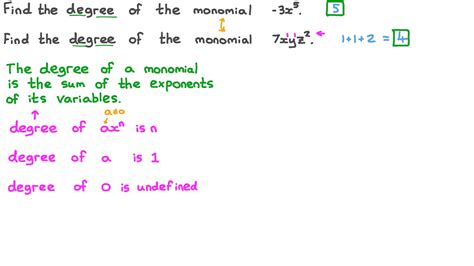Find The Degree Of A Monomial
News Co
Apr 07, 2025 · 5 min read

Table of Contents
Finding the Degree of a Monomial: A Comprehensive Guide
Understanding the degree of a monomial is fundamental to mastering algebra and polynomial manipulation. This comprehensive guide will delve into the concept, providing clear explanations, practical examples, and advanced considerations to solidify your understanding. We'll cover everything from the basics to more complex scenarios, equipping you with the knowledge to confidently tackle any monomial degree problem.
What is a Monomial?
Before we dive into the degree, let's ensure we have a solid grasp of what a monomial actually is. A monomial is a single term algebraic expression that is a product of constants and variables raised to non-negative integer powers. This means it contains no addition or subtraction operations.
Examples of Monomials:
- 5x²
- -3xyz
- 7
- x⁴y³z
- 1/2 a²b
Non-Examples of Monomials:
- 2x + 3 (contains addition)
- x⁻² (negative exponent)
- 5/x (variable in the denominator)
- √x (variable under a root)
Defining the Degree of a Monomial
The degree of a monomial is the sum of the exponents of all its variables. Let's break this down with examples:
Example 1: Find the degree of the monomial 5x².
Here, the variable x has an exponent of 2. Therefore, the degree of the monomial 5x² is 2.
Example 2: Find the degree of the monomial -3xyz.
Each variable (x, y, and z) has an exponent of 1 (implicitly). Therefore, the degree is 1 + 1 + 1 = 3.
Example 3: Find the degree of the monomial 7.
The constant term 7 can be considered as 7x⁰, where the exponent of x is 0. The degree is therefore 0. Constants always have a degree of 0.
Example 4: Find the degree of the monomial x⁴y³z.
The exponents of x, y, and z are 4, 3, and 1 respectively. The degree is 4 + 3 + 1 = 8.
Example 5: Find the degree of the monomial 1/2 a²b.
The exponents of a and b are 2 and 1 respectively. The degree is 2 + 1 = 3. The constant coefficient (1/2) doesn't affect the degree.
Handling More Complex Monomials
While the examples above are straightforward, let's tackle some more challenging scenarios:
Scenario 1: Monomials with multiple occurrences of the same variable:
Consider the monomial 4x³y²x². Before determining the degree, we must simplify the monomial by combining like terms:
4x³y²x² = 4x⁵y²
Now, the degree is 5 + 2 = 7.
Scenario 2: Monomials with coefficients:
The coefficient of a monomial does not influence its degree. For example, the monomial -25a⁴b³ has a degree of 4 + 3 = 7. The coefficient (-25) is irrelevant to the degree calculation.
Scenario 3: Zero as a coefficient:
The monomial 0x⁵y² is equivalent to 0. Its degree is undefined, or sometimes considered to be -∞ (negative infinity) in advanced mathematical contexts. It's crucial to remember that this is a special case.
Scenario 4: Monomials involving negative exponents (outside the definition):
Expressions such as 3x⁻² are not monomials according to our definition because they contain negative exponents. Therefore, the concept of degree doesn't directly apply. These expressions would be considered terms within rational functions.
Applications of Finding the Degree of a Monomial
Understanding the degree of a monomial is crucial for several algebraic operations and concepts:
1. Determining the Degree of a Polynomial
A polynomial is a sum of monomials. The degree of a polynomial is determined by the highest degree among its constituent monomials. This is a direct application of our understanding of monomial degrees.
2. Polynomial Operations: Addition and Subtraction
When adding or subtracting polynomials, combining like terms often requires identifying terms with the same degree. Knowing the degree of each monomial streamlines this process.
3. Polynomial Operations: Multiplication
Multiplying polynomials involves multiplying monomials. The degree of the resulting monomial product is the sum of the degrees of the original monomials. This understanding simplifies calculations and helps predict the degree of the resulting polynomial.
4. Polynomial Division
The degree of the quotient and remainder in polynomial division is related to the degrees of the divisor and dividend. Understanding monomial degrees forms the foundation of this relationship.
5. Applications in Calculus
In calculus, the degree of a monomial is essential when dealing with derivatives and integrals of polynomials.
6. Linear Algebra and Matrix Operations
Monomials, and consequently their degrees, play a significant role in linear algebra applications, particularly in the context of polynomial matrices and their operations.
Advanced Considerations: Multivariable Monomials and Beyond
In the context of multivariable monomials (monomials with more than one variable), the degree provides valuable information about the complexity and behavior of the expression. For instance, higher-degree multivariable monomials can represent more intricate relationships between variables.
Conclusion: Mastering Monomial Degrees for Algebraic Success
Understanding how to find the degree of a monomial is a cornerstone of algebraic proficiency. This comprehensive guide has equipped you with the knowledge and skills to confidently determine the degree of any monomial, navigate complex scenarios, and apply this understanding in various algebraic contexts. Remember, consistent practice is key to mastering this fundamental concept. By solidifying your understanding of monomial degrees, you'll pave the way for a stronger foundation in algebra and related mathematical fields. The concepts discussed here are essential for understanding polynomials, their operations, and many higher-level mathematical concepts. Regular practice and a firm grasp of the definitions will ensure your success.
Latest Posts
Related Post
Thank you for visiting our website which covers about Find The Degree Of A Monomial . We hope the information provided has been useful to you. Feel free to contact us if you have any questions or need further assistance. See you next time and don't miss to bookmark.